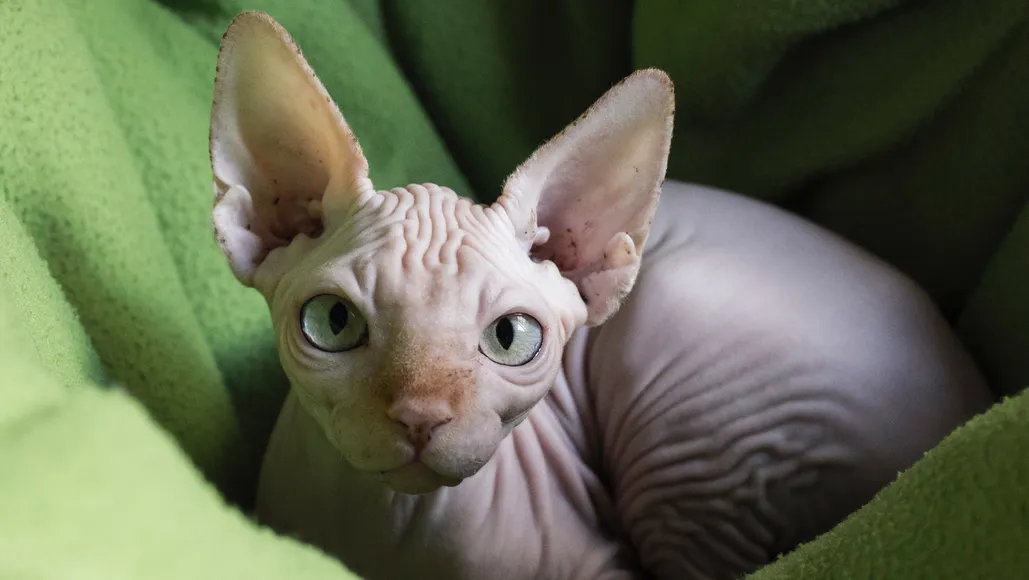Hairless cats, like the Sphynx and Donskoy, are very popular among pet lovers. This makes them some of the pricier cat breeds. Their prices range from $1,500 to over $3,000. Several factors, including breeding costs and care needs, explain these high prices.
This article will look into what makes hairless cats so costly. We’ll cover their breeding challenges, care specifics, and the role of reputable breeders.
Key Takeaways
- Hairless cats are among the most expensive cat breeds, with prices influenced by various factors.
- Breeding challenges and health considerations play a significant role in establishing their costs.
- The cost of hairless cat care includes unique grooming needs and specialized nutrition.
- Demand and availability in the market can affect pricing as well.
- Choosing a responsible breeder influences both the price and the health of the cat.
Introduction to Hairless Cats
Hairless cats are unique among cat breeds because of their striking looks and special traits. The Sphynx cat is a well-known breed, known for its lack of fur and big, expressive eyes. It has won the hearts of many with its loving and outgoing personality.
Their lack of fur comes from a genetic mutation in feline genetics. This mutation gives them a unique look that attracts attention. Sphynx cats need careful breeding to keep their desired traits while ensuring their health.
Hairless cats are not just pretty; they have unique personalities too. They are full of energy and love to play, making them great companions. Owners will find them engaging and fun to be around, as they love being social and having company.
Potential owners need to know how to care for hairless cats. They need different grooming and care than cats with fur. Learning about their needs makes them even more special in the world of unique cat breeds.
The Popularity of Hairless Cat Breeds
The popularity of hairless cats has grown a lot in recent years. This is thanks to social media and more people becoming cat lovers. The Sphynx breed has become especially popular because of its unique look and friendly nature.
Now, people want pets that are more interactive and loving. Celebrities have helped make the Sphynx breed more popular. They show off their love for these hairless cats, making them more wanted.
The American Kennel Club has seen a big increase in Sphynx breed registrations. This shows how much people love these hairless cats. Also, campaigns about their care and nature have helped make them more popular.
| Year | Sphynx Registrations | Overall Cat Ownership Trends |
|---|---|---|
| 2019 | 1,200 | 53 million |
| 2020 | 1,500 | 56 million |
| 2021 | 2,000 | 58 million |
| 2022 | 2,700 | 60 million |
People are now choosing pets that are more social and loving. As more learn about hairless breeds, their popularity is likely to keep growing.

Why Are Hairless Cats So Expensive
Understanding the costs of hairless cats involves looking at several factors, especially in breeding. Breeders face unique challenges in cat breeding that affect the costs. These challenges include the time and knowledge needed for successful breeding.
Breeding Challenges and Costs
Breeding hairless cats, like Sphynx, comes with specific costs. Breeders must follow ethical practices and understand genetic health issues in hairless cats. This requires a big investment in time and resources, especially for potential birth complications or health issues in the cats.
Health Considerations of Hairless Cats
Health issues are a big part of the cost of hairless cats. Many Sphynx cats have conditions like hypertrophic cardiomyopathy and skin sensitivities. These issues mean more vet visits. Owners need to think about the long-term costs, including the initial price and ongoing medical bills.
Cost of Care for Hairless Cats
Owning a hairless cat, like a Sphynx, means more than just the usual pet care. You need to think about their special grooming and diet needs. It’s key to know these things to take good care of these unique cats.
Unique Grooming Needs
Since hairless cats don’t have fur, they can’t be groomed the same way as furry cats. They need regular baths to stay clean. This is because they produce more oil without fur, which can get oily if not washed away.
They also need their nails trimmed and ears cleaned regularly. This keeps them comfortable and healthy.
Here are some grooming tasks to consider:
- Weekly baths: Remove oil buildup from the skin.
- Nail trimming: Prevent discomfort and injury.
- Ear cleaning: Maintain hygiene for hairless breeds.
Nutrition and Diet Requirements
What a hairless cat eats is very important for their health. They need a lot of protein to keep their skin healthy and growing right. It’s important for owners to learn about the special diet needs of Sphynx cats.
Here are some important diet points:
- High protein content: Supports muscle health and skin vitality.
- Balanced nutrients: Vital for overall well-being.
- Specialized cat food: May offer tailored nutrition for hairless breeds.
| Grooming Task | Frequency | Purpose |
|---|---|---|
| Bathing | Weekly | Remove oil buildup |
| Nail Trimming | Bi-weekly | Prevent discomfort |
| Ear Cleaning | Monthly | Maintain hygiene |
In summary, taking care of hairless cats means paying attention to their grooming and diet. Knowing these things helps owners get ready for the special care Sphynx cats need.
Demand and Availability in the Market
The market demand for hairless cats has grown a lot in recent years. Their unique look and loving nature draw in more people. This rise in popularity comes from their often seen in media and ads, making them more interesting to potential owners.
Because of this, finding these cats can be hard due to their limited number. Good breeders often have long waiting lists, making it harder to get a hairless cat. This affects hairless cat pricing, making them more expensive because they are rare.
People looking to adopt might look at rescues as a cheaper option. But, cat adoption rates for hairless cats are much lower than for regular breeds. This shows we need to spread the word more about adopting hairless cats. It helps more people think about these loving pets and meets the market’s demand.
Influence of Reputable Breeders
Finding the right breeder is key to getting a healthy, well-socialized hairless cat. Good breeders focus on responsible practices for the kittens’ health and breed standards. When picking a Sphynx cat breeder, look for transparency in breeding methods, health guarantees, and customer feedback.
Choosing a Responsible Breeder
When searching for a reputable breeder, some qualities are important. They should be open about their breeding methods. They share details on health screenings and the health history of kittens. Here are key traits to look for:
- Health Checks: Good breeders check the health of their cats to prevent genetic disorders.
- Ethical Practices: They focus on the cats’ health and welfare, not just making money.
- Customer Reviews: Positive reviews from past buyers show a breeder’s trustworthiness and commitment.
- Support and Guidance: Great breeders help new owners with advice on caring for Sphynx cats.
Knowing these points helps buyers make better choices. It means supporting breeders who help the feline community.

Conclusion
The costs of owning hairless cats come from several factors. These include the challenges of breeding due to health issues and the need for special care. Owners must also be ready for the extra grooming and diet needs. This makes owning a hairless cat a big financial and emotional commitment.
The future looks bright for hairless cat owners, with more people interested in them. Breeders might improve their practices, making these cats healthier and more available. But, new owners need to know the special care these cats need. Being well-informed is key to enjoying life with a hairless cat.
When thinking about getting a hairless cat, consider their unique beauty and the care they need. This knowledge will help make a good pet choice. It ensures a happy life for both the cat and its owner.
FAQ
Why are hairless cats like Sphynx so expensive?
Why are hairless cats like Sphynx so expensive?
FAQ
Why are hairless cats like Sphynx so expensive?
Hairless cats, especially Sphynx, cost a lot because they are rare and hard to breed. Their health needs and the quality of breeders also add to the cost. Prices can go from
FAQ
Why are hairless cats like Sphynx so expensive?
Hairless cats, especially Sphynx, cost a lot because they are rare and hard to breed. Their health needs and the quality of breeders also add to the cost. Prices can go from $1,500 to over $3,000.
What are the common health issues associated with hairless cats?
Hairless cats often face health problems like hypertrophic cardiomyopathy and skin issues. It’s important to keep them healthy with regular check-ups and care.
How should I groom a hairless cat?
Caring for hairless cats means they need regular baths to keep their skin clean. Don’t forget to trim their nails and clean their ears for hygiene.
What dietary needs do hairless cats have?
Hairless cats need a diet high in protein to stay healthy. Owners should feed them balanced meals that help keep their skin and overall health in top shape.
How does the demand for hairless cats affect their pricing?
More people want hairless cats because of media and celebrity interest. Since they’re not easy to find, their prices go up due to their rarity.
What should I look for in a reputable hairless cat breeder?
Look for an open breeder, offers health guarantees, and has good reviews. Good breeders focus on ethics and health checks, which affects their cat prices.
Are there specific grooming products recommended for hairless cats?
Yes, use gentle, hypoallergenic shampoos and conditioners made for hairless cats. Also, keep up with nail clippers and ear cleaning to keep them clean.
Can hairless cats be adopted from shelters or rescues?
Yes, you can find hairless cats in shelters or rescues, though they’re not common. Adopting can be cheaper than buying from a breeder, but it depends on availability.
What are the common health issues associated with hairless cats?
Hairless cats often face health problems like hypertrophic cardiomyopathy and skin issues. It’s important to keep them healthy with regular check-ups and care.
How should I groom a hairless cat?
Caring for hairless cats means they need regular baths to keep their skin clean. Don’t forget to trim their nails and clean their ears for hygiene.
What dietary needs do hairless cats have?
Hairless cats need a diet high in protein to stay healthy. Owners should feed them balanced meals that help keep their skin and overall health in top shape.
How does the demand for hairless cats affect their pricing?
More people want hairless cats because of media and celebrity interest. Since they’re not easy to find, their prices go up due to their rarity.
What should I look for in a reputable hairless cat breeder?
Look for an open breeder, offers health guarantees, and has good reviews. Good breeders focus on ethics and health checks, which affects their cat prices.
Are there specific grooming products recommended for hairless cats?
Yes, use gentle, hypoallergenic shampoos and conditioners made for hairless cats. Also, keep up with nail clippers and ear cleaning to keep them clean.
Can hairless cats be adopted from shelters or rescues?
Yes, you can find hairless cats in shelters or rescues, though they’re not common. Adopting can be cheaper than buying from a breeder, but it depends on availability.
What are the implications of hairless cat ownership on household care?
Having a hairless cat means you must commit to regular grooming, special diets, and health monitoring. This requires more care than traditional cats.

